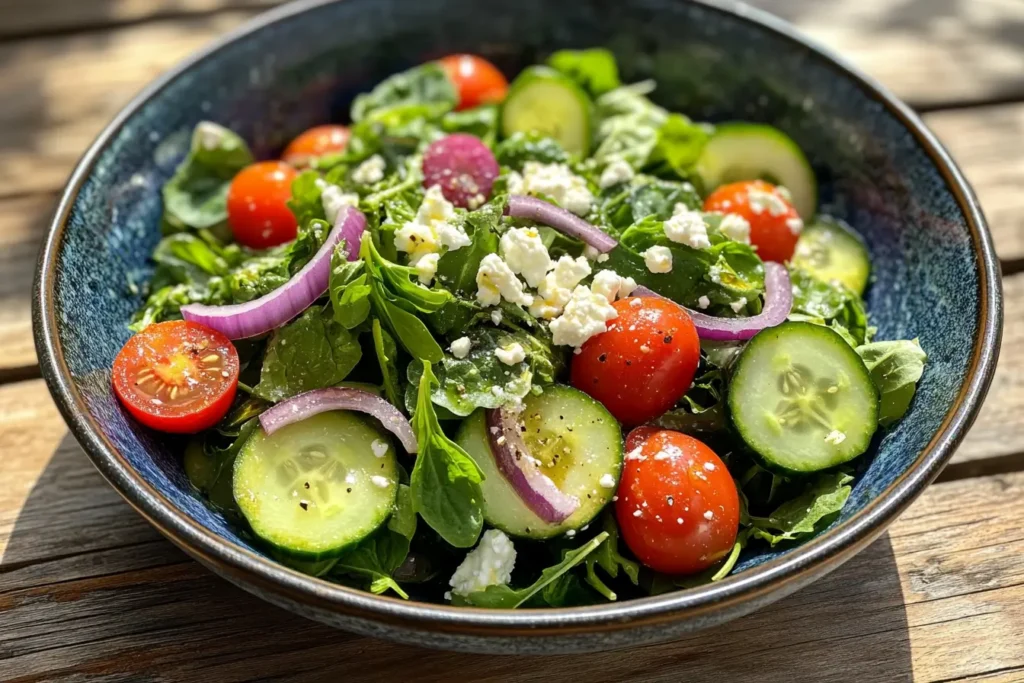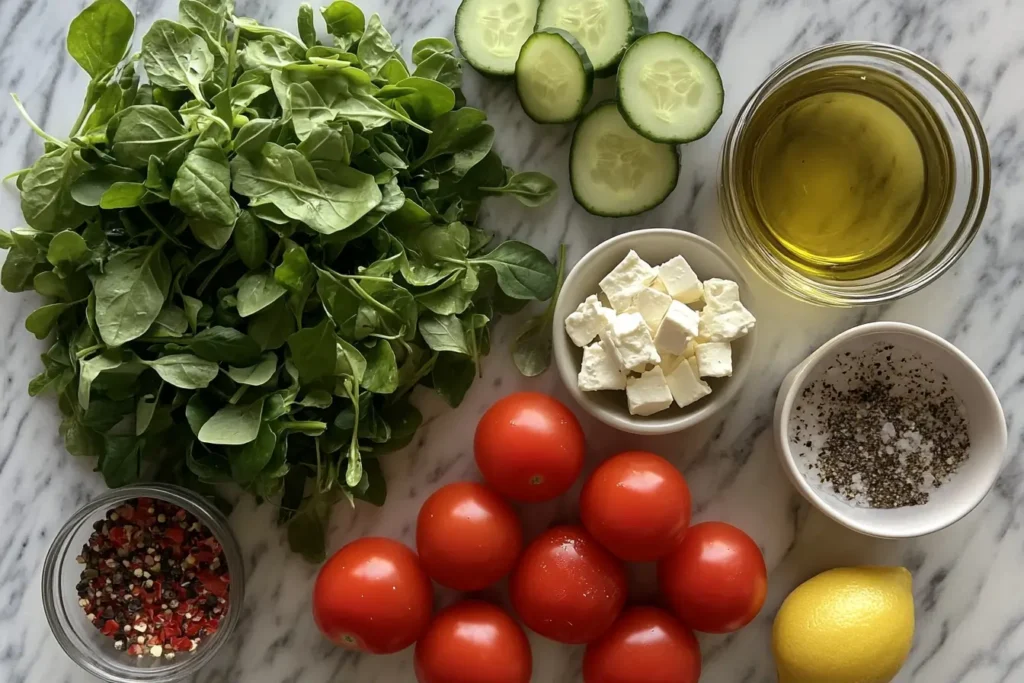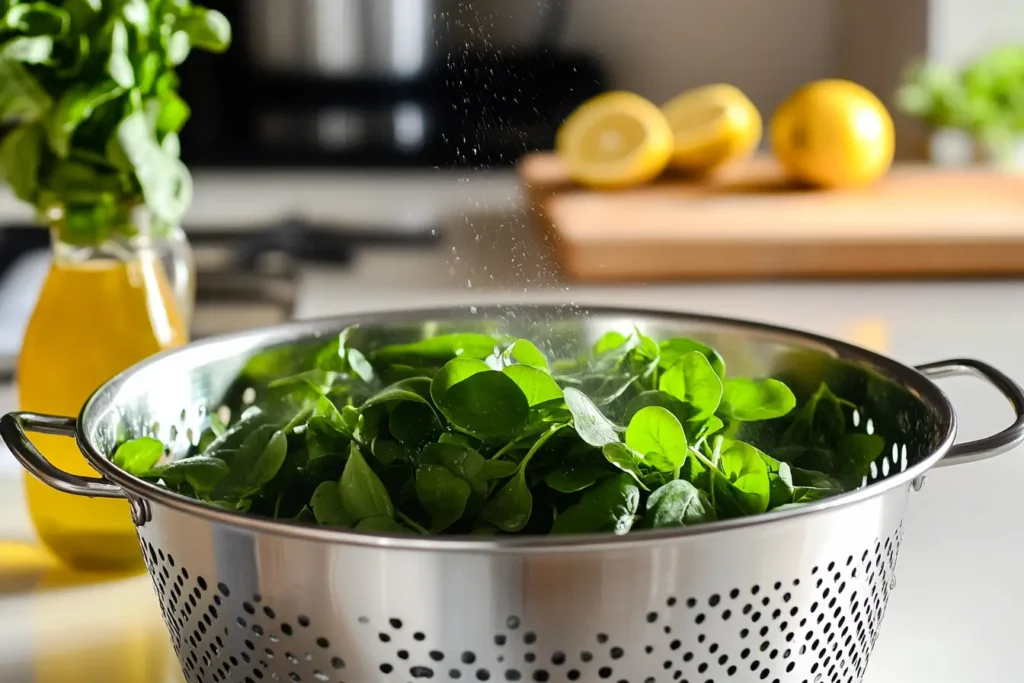Have you ever tasted something so fresh and vibrant that it felt like a burst of sunshine in your mouth? That’s watercress salad for you! This humble leafy green might not be the star of every salad bar, but trust me, it’s a game-changer. Whether you’re a health enthusiast, a foodie, or just someone looking to spice up your meals, watercress salad is here to wow you.
But what makes watercress so special? Is it the peppery kick? The nutrient-packed leaves? Or the fact that it pairs beautifully with almost anything? Spoiler alert: it’s all of the above. In this guide, we’ll explore everything you need to know about watercress salad—from its rich history to its health benefits, and of course, how to make the perfect bowl. Ready to fall in love with this underrated superfood? Let’s dig in!

Table of Contents
What is Watercress? A Nutrient-Packed Superfood
The History of Watercress: From Ancient Medicine to Modern Kitchens
Watercress isn’t just another leafy green—it’s a culinary and medicinal powerhouse with a history as rich as its flavor. Did you know that ancient Greeks and Romans used watercress as a natural remedy for everything from hair loss to bad breath? Hippocrates, the father of modern medicine, even built his first hospital near a stream so he could grow fresh watercress for his patients. Talk about dedication!
Fast forward to today, and watercress has earned its place in modern kitchens worldwide. Its peppery taste and crunchy texture make it a versatile ingredient, perfect for salads, soups, and even smoothies. But what really sets watercress apart is its incredible nutritional profile.
Nutritional Benefits of Watercress: Why It’s a Health Powerhouse
Let’s get scientific for a moment. Watercress is packed with vitamins, minerals, and antioxidants that can do wonders for your health. Here’s a quick breakdown:
- Vitamin K: Essential for bone health and blood clotting.
- Vitamin C: Boosts immunity and promotes healthy skin.
- Calcium: Strengthens bones and teeth.
- Antioxidants: Fight inflammation and protect against chronic diseases.
In fact, watercress is so nutrient-dense that it’s often ranked as one of the healthiest vegetables on the planet. As the saying goes:
“Watercress is like a multivitamin in leafy green form—nature’s way of keeping you healthy and happy.”
How to Make the Perfect Watercress Salad

Essential Ingredients for a Classic Watercress Salad
Before we jump into the recipe, let’s talk about what makes a watercress salad truly shine. The key is balance. The peppery flavor of watercress pairs beautifully with sweet, tangy, and crunchy elements. Here’s what you’ll need:
- Fresh watercress: Look for bright green leaves with no wilting.
- Lemon vinaigrette: A simple mix of lemon juice, olive oil, salt, and pepper.
- Cherry tomatoes: For a pop of color and sweetness.
- Cucumber: Adds a refreshing crunch.
- Red onion: For a hint of sharpness.
- Feta cheese: Optional, but highly recommended for a creamy contrast.
Step-by-Step Recipe: Simple Watercress Salad with Lemon Vinaigrette
Now, let’s get cooking! This recipe is so easy, you’ll wonder why you haven’t been making watercress salad all along.
Ingredients:
- 4 cups fresh watercress
- 1 cup cherry tomatoes, halved
- 1 cucumber, thinly sliced
- 1/4 red onion, thinly sliced
- 1/4 cup crumbled feta cheese (optional)
- 3 tbsp olive oil
- 1 tbsp lemon juice
- Salt and pepper to taste
Instructions:
- Wash and Prep: Rinse the watercress thoroughly and pat it dry. Chop the cherry tomatoes, cucumber, and red onion.
- Make the Dressing: In a small bowl, whisk together olive oil, lemon juice, salt, and pepper.
- Assemble the Salad: In a large bowl, combine watercress, cherry tomatoes, cucumber, and red onion. Toss gently to mix.
- Add the Dressing: Drizzle the lemon vinaigrette over the salad and toss again.
- Finish with Feta: Sprinkle crumbled feta cheese on top (if using).
- Serve and Enjoy: Serve immediately for the freshest flavor.
Nutrition Facts (Per Serving):
| Nutrient | Amount |
|---|---|
| Calories | 120 |
| Total Fat | 9g |
| Saturated Fat | 2g |
| Cholesterol | 5mg |
| Sodium | 150mg |
| Total Carbohydrates | 8g |
| Dietary Fiber | 2g |
| Sugars | 4g |
| Protein | 3g |
| Vitamin A | 50% DV |
| Vitamin C | 70% DV |
| Calcium | 10% DV |
| Iron | 6% DV |
Creative Variations: Adding Fruits, Nuts, and Proteins
If you’re feeling adventurous, why not mix things up? Watercress salad is incredibly versatile. Here are a few ideas to inspire you:
- Add Fruits: Toss in some sliced strawberries, apples, or pears for a sweet contrast.
- Go Nuts: Sprinkle toasted almonds, walnuts, or pecans for extra crunch.
- Boost Protein: Add grilled chicken, shrimp, or boiled eggs to turn your salad into a hearty meal.
The possibilities are endless, so don’t be afraid to get creative!
Health Benefits of Watercress Salad
Boosts Immunity with Vitamins and Antioxidants
Watercress is a vitamin C powerhouse, which means it’s great for keeping colds and flu at bay. Plus, its antioxidants help fight free radicals, reducing inflammation and keeping your immune system strong.
Supports Bone Health with Calcium and Vitamin K
If you’re looking to strengthen your bones, watercress has got you covered. It’s rich in calcium and vitamin K, both of which are essential for maintaining bone density and preventing osteoporosis.
Aids Digestion and Promotes Gut Health
Thanks to its high fiber content, watercress can help keep your digestive system running smoothly. It’s also packed with water, which helps hydrate your body and flush out toxins.
“Love experimenting with dressings? Try our 5 Ingredient Taco Soup”
Common Problems with Watercress Salad (and How to Solve Them)
Problem: Watercress Tastes Too Bitter
Let’s face it—watercress has a distinct peppery flavor that can sometimes border on bitter. If you’re not a fan of bitter greens, this might be a turn-off. But don’t worry, there’s a simple solution!
Solution: Balance with Sweet or Tangy Ingredients
The key to taming the bitterness of watercress is to balance it with sweet or tangy elements. For example:
- Add honey or maple syrup to your dressing for a touch of sweetness.
- Toss in citrus fruits like oranges or grapefruits for a tangy contrast.
- Sprinkle dried cranberries or pomegranate seeds for a burst of natural sweetness.
As the saying goes:
“A little sweetness can turn bitterness into bliss.”
Problem: Watercress Wilts Quickly
Watercress is a delicate green, and if not stored properly, it can wilt faster than you can say “salad.” But with a few simple tricks, you can keep it fresh and crisp.
Solution: Proper Storage and Freshness Tips
Here’s how to keep your watercress fresh:
- Store in Water: Place the stems in a jar of water (like a bouquet) and cover the leaves with a plastic bag. Keep it in the fridge.
- Use a Damp Paper Towel: Wrap the watercress in a damp paper towel and store it in a sealed container.
- Buy Fresh: Always choose watercress with bright green leaves and firm stems. Avoid any bunches that look slimy or yellow.
Pairing Watercress Salad with Other Dishes
Perfect Pairings: Proteins, Grains, and Soups
Watercress salad isn’t just a side dish—it’s a versatile companion to a variety of meals. Here are some pairing ideas to inspire you:
- With Proteins: Serve alongside grilled salmon, roasted chicken, or seared tofu for a balanced meal.
- With Grains: Add a handful of cooked quinoa, farro, or couscous to your salad for extra texture and heartiness.
- With Soups: Pair with a creamy soup like butternut squash or tomato basil for a light yet satisfying combo.
Watercress Salad as a Side Dish or Main Course
Whether you’re hosting a dinner party or enjoying a quiet meal at home, watercress salad can play multiple roles. As a side dish, it adds a refreshing contrast to rich, heavy meals. As a main course, it can be bulked up with proteins and grains for a filling yet healthy option.
Seasonal Watercress Salad Ideas
Spring and Summer Watercress Salads: Light and Refreshing
When the weather warms up, your salads should too! Here are some ideas for spring and summer:
- Strawberry Watercress Salad: Combine watercress with fresh strawberries, goat cheese, and a balsamic vinaigrette.
- Watermelon Watercress Salad: Mix watercress with cubed watermelon, feta cheese, and mint leaves for a hydrating treat.
- Citrus Watercress Salad: Toss watercress with orange segments, avocado, and a citrus dressing.
Fall and Winter Watercress Salads: Warm and Hearty
As the temperatures drop, your salads can still shine with these cozy ideas:
- Roasted Veggie Watercress Salad: Add roasted butternut squash, sweet potatoes, and a sprinkle of pumpkin seeds.
- Apple Walnut Watercress Salad: Combine watercress with sliced apples, toasted walnuts, and a maple-mustard dressing.
- Warm Bacon Watercress Salad: Toss watercress with crispy bacon, roasted potatoes, and a warm vinaigrette.
Watercress Salad for Special Diets

Vegan and Vegetarian Watercress Salad Options
Watercress salad is naturally vegan and vegetarian-friendly, but here are some tips to make it even more exciting:
- Vegan Cheese: Swap feta for a plant-based alternative like almond or cashew cheese.
- Protein Boost: Add chickpeas, lentils, or tempeh for a hearty, protein-packed meal.
- Creamy Dressings: Use tahini or avocado-based dressings for a rich, dairy-free option.
Gluten-Free and Low-Carb Watercress Salad Recipes
If you’re following a gluten-free or low-carb diet, watercress salad is a perfect choice. Here’s how to keep it compliant:
- Skip the Croutons: Instead, add nuts or seeds for crunch.
- Choose Gluten-Free Grains: If adding grains, opt for quinoa or rice.
- Low-Carb Dressings: Stick to olive oil, lemon juice, and vinegar-based dressings.
FAQs About Watercress Salad
1. What does watercress taste like?
Watercress has a distinct peppery flavor, similar to arugula but with a slightly more intense kick. It’s fresh, crisp, and slightly tangy, making it a great addition to salads, soups, and sandwiches.
2. Can I eat watercress raw in a salad?
Absolutely! Watercress is delicious raw and adds a refreshing crunch to salads. Just make sure to wash it thoroughly before using it.
3. How long does watercress last in the fridge?
When stored properly (in a jar of water or wrapped in a damp paper towel), watercress can last up to 5 days in the fridge. However, it’s best enjoyed fresh.
4. Are there any side effects of eating watercress?
Watercress is generally safe to eat, but consuming it in excessive amounts may cause stomach discomfort for some people due to its high fiber content. If you’re on blood thinners, consult your doctor, as watercress is rich in vitamin K, which can affect blood clotting.
Conclusion: Elevate Your Meals with Watercress Salad
Watercress salad isn’t just a dish—it’s an experience. From its rich history to its incredible health benefits, this leafy green has earned its place as a superfood superstar. Whether you’re whipping up a quick lunch, hosting a dinner party, or simply looking to add more greens to your diet, watercress salad is a versatile, delicious, and nutritious choice.
So, what are you waiting for? Grab a bunch of watercress, get creative with your ingredients, and let your taste buds dance with joy. As the saying goes:
“Good food is the foundation of genuine happiness.”
And with watercress salad, happiness is just a bite away.
